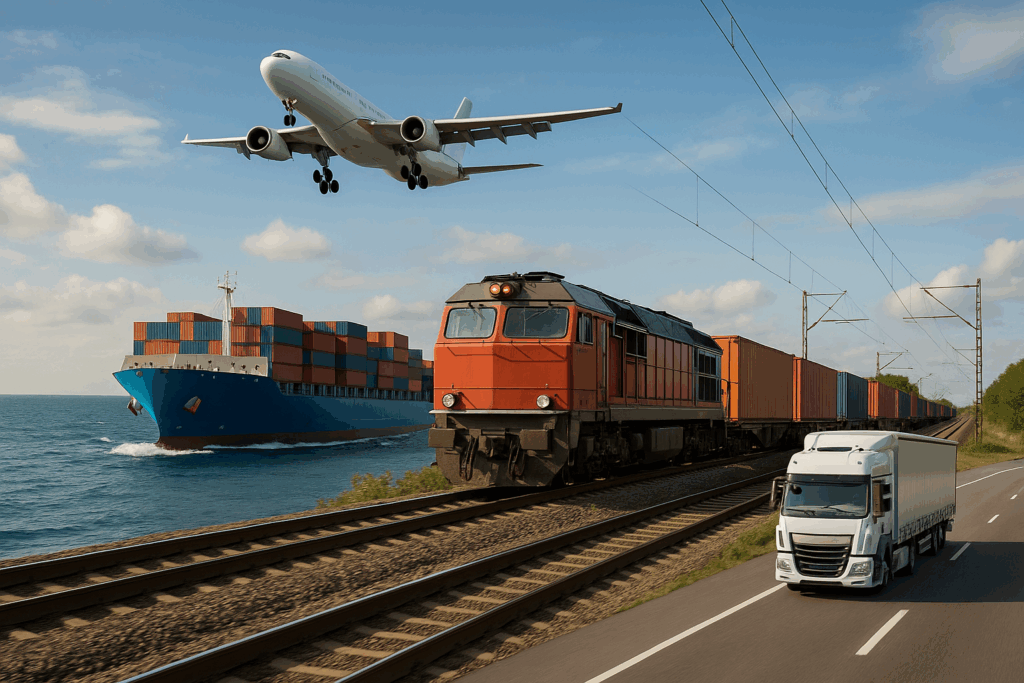In 2025, importing into the United States from China remains one of the most important channels for global trade. From electronics and apparel to industrial components, U.S. businesses rely on Chinese manufacturers for competitive pricing and diverse product ranges.
However, successful importing isn’t just about buying goods — it requires understanding shipping methods, customs regulations, delivery timelines, and international trade terms. A clear plan can save you money, avoid delays, and ensure your shipments arrive in perfect condition.
1. Main Shipping Methods for Importing from China to the U.S.
When importing, the first step is selecting the right transportation method. The choice depends on your budget, shipment size, urgency, and product type.
Primary options:
- Air Freight – Fast but costlier, ideal for urgent goods.
- Sea Freight (FCL/LCL) – Economical for bulk cargo, slower transit time.
- Express Courier – Best for small parcels needing quick delivery.
- Rail + Truck Combination – Less common, but can be competitive for certain inland U.S. destinations.
2. Shipping Time, Conditions & Terms
| Mode of Transport | Average Transit Time | Conditions & Terms | Best For |
|---|---|---|---|
| Air Freight | 3–7 days | FOB, CIF, DAP available; weight-based pricing; must clear U.S. customs | Urgent shipments, high-value goods |
| Sea Freight (FCL) | 25–35 days | FOB, CIF; container load; port-to-port or door-to-door | Large volumes, heavy cargo |
| Sea Freight (LCL) | 28–40 days | Consolidated cargo; more handling; FOB/CIF | Medium loads, cost-sharing |
| Express Courier | 3–5 days | DDP possible; all-inclusive price; customs handled by courier | Samples, small packages |
| Rail + Truck | 20–28 days | Multi-modal; limited routes; FOB/CIF | Non-urgent but time-sensitive inland deliveries |

3. Key Import Regulations You Must Know
The U.S. has strict rules for imported goods:
- Customs Declaration – Filing entry documentation with U.S. Customs and Border Protection (CBP).
- HS Code Classification – Correct tariff codes to determine duties.
- Import Licenses – Certain products require federal agency approval (e.g., FDA, USDA).
- Duty & Tax Payment – Based on product value and classification.
- Compliance with U.S. Standards – Safety, labeling, and packaging requirements.
4. Cost Factors When Importing into the U.S. from China
Import costs include more than just the supplier’s price. Consider:
- Product cost
- Freight charges
- Customs duties & taxes
- Insurance
- Handling fees
- Port service fees
💡 Tip: Using the right Incoterms (e.g., FOB vs. CIF vs. DDP) can shift certain costs from you to the supplier or freight forwarder.
5. Choosing the Right Freight Forwarder
A reliable freight forwarder can make importing far smoother. Look for:
- Strong U.S.–China trade experience.
- Transparent pricing.
- Assistance with customs clearance.
- Multiple shipping method options.
- Real-time tracking and communication.

6. Tips for Faster & Safer Importing
- Plan shipments ahead, especially before U.S. holidays.
- Double-check HS codes to avoid customs delays.
- Use professional packaging to reduce damage risk.
- Choose DDP or CIF terms if you prefer less customs responsibility.
- Monitor shipment tracking closely for any port congestion updates.
7. Seasonal & Holiday Impact on Shipping
Import times and costs can change dramatically depending on the time of year.
| Season / Holiday | Impact on Shipping | Recommendation |
|---|---|---|
| Chinese New Year (Jan–Feb) | Factory closures cause production delays; space shortage | Book at least 4 weeks earlier |
| Golden Week (Oct) | Port congestion in China; higher rates | Ship before late September |
| Christmas Peak (Nov–Dec) | Increased demand for U.S. retail imports | Secure capacity early |
| Hurricane Season (Jun–Nov) | Potential delays at Gulf & East Coast ports | Consider West Coast ports |
| Back-to-School (Jul–Aug) | Surge in consumer goods shipping | Lock in contracts in advance |
8. Common Mistakes to Avoid
- Choosing the cheapest rate without checking transit reliability.
- Not verifying supplier’s export documents.
- Ignoring customs duty estimates before purchasing.
- Underinsuring shipments.
- Missing seasonal demand forecasts.
9. Sustainability & Green Shipping Trends
Eco-conscious importing is becoming a priority:
- Low-emission vessels & aircraft – Reducing carbon footprint.
- Optimized routes – Lower fuel usage.
- Sustainable packaging – Meeting U.S. retailer requirements.
- Carbon offset programs – Offered by certain carriers.
10. Insurance Options for Imports
Protect your cargo against damage, theft, or loss:
- All-Risk Coverage – Comprehensive protection.
- Named Perils Coverage – Specific risks covered.
- Total Loss Coverage – Only total shipment loss is covered.
11. Conclusion
Importing from China to the U.S. can be highly profitable if you plan strategically. Choosing the right shipping method, understanding regulations, preparing for seasonal changes, and working with a trusted freight forwarder will ensure smooth operations and cost efficiency.
Request a Quote
Need a tailored solution for your shipping from China?
Let TJ China Freight Forwarder assist you with reliable, cost-effective service.
FAQ:
Q1.What documents are required for importing into the U.S. from China?
Commercial invoice, packing list, bill of lading/airway bill, arrival notice, and any required permits.
Q2.Can I import into the U.S. without a customs broker?
Yes, but using a licensed customs broker simplifies the process and reduces clearance delays.
Q3.How do U.S. import duties work?
Duties are calculated based on the HS code, product value, and trade agreements.
Q4.Are there restricted products from China to the U.S.?
Yes — items like hazardous chemicals, counterfeit goods, and banned agricultural products are prohibited.
Q5.Does the U.S.–China trade war still impact import tariffs in 2025?
Yes, certain products still face additional tariffs depending on trade policy updates.
